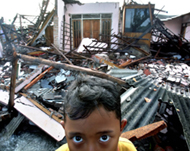Java quake caused by Ring of Fire
Experts believe the earthquake in Indonesia and subsequent tremors that shook Papua New Guinea and Tonga are all linked to the Pacific’s Ring of Fire.

A day after an earthquake measuring 6.3 on the Richter scale left more than 3,300 people dead two more quakes of similar size could be felt in the two Pacific nations within 15 minutes of each other on Sunday morning.
Although the earthquakes were as powerful as the one which hit the central Indonesian island of Java, there were no reports of deaths or subsequent tsunamis.
The Pacific’s volatile Ring of Fire unleashed two more earthquakes on Sunday, a day after an earthquake in Indonesia left more than 3,300 dead in one of the world’s most seismically active regions.
Experts believe recent activity in the Earth’s crust, including the rumbling of the Mount Merapi volcano near the epicentre of Saturday’s quake, has all been linked to the ring.
Gary Gibson, a seismology professor with the RMIT University in Melbourne, Australia, said: “There’s no doubt they are effects of the same cause – the ring of weakness in the Earth’s surface.”
Fault lines
The ring, which stretches from the western coast of the Americas, through the island nations of the South Pacific, then on through Southeast Asia, is a series of fault lines, also known as weaknesses, in the hardened upper layers of the Earth’s surface, the crust.
These lines of weakness are where huge continental plates that make up the crust meet and literally float on the molten rock of the Earth’s core.
These plates are in constant motion, either clashing into or moving away from each other, creating stresses and pressure at their margins.
|
“Earthquakes do tend to happen in clusters but they aren’t triggered by one another” Gary Gibson, |
This stress is released through volcanic eruptions, when the molten rock is ejected as magma through fissures in the crust, or via earthquakes, when the pressure causes the crust to buckle and shift.
Most of these seismic events are small and occur underwater, where the majority of the continental plate margins are found.
According to the US Geological Survey (USGS) there has been an average of 19.4 quakes of 7.0-plus strength on the ring each year.
Disaster zone
Indonesia has suffered from three catastrophic earthquakes in the past 18 months.
The 9.3-magnitude earthquake on December 26, 2004, caused the tsunamis that hit Indian Ocean shorelines and killed 168,000 in Indonesia’s Aceh province alone.
An 8.7-quake just 160km (100 miles) to the south on March 28, 2005, killed more than 600.
Gibson said that the flurry of seismic activity of the past days was comparatively small.
“On any given day, you would find seismic activity greater than this throughout the Pacific region,” he said.
 |
|
Indonesia has been hit by three |
“Last week there was a sequence of earthquakes between New Zealand and Tonga that were far greater – we got up to magnitude of 7.8 on one day,” he said. “But nobody knows anything about it because it didn’t affect anybody.”
Although this activity is the result of the weak points in the Earth’s surface, experts are not convinced that they create a ripple, or domino effect, of one quake setting off another.
“Earthquakes do tend to happen in clusters, but they aren’t triggered by one another,” he said.
“The seismic wave created by an earthquake can travel for hundreds of kilometres and then dissipate. The Earth’s crust is actually very good at absorbing that energy.”